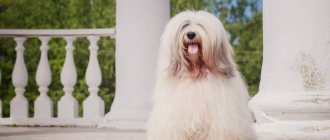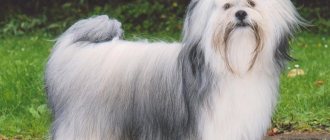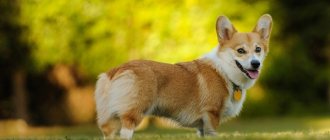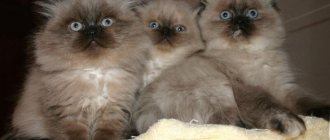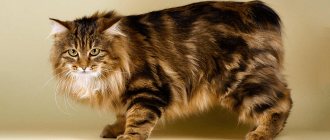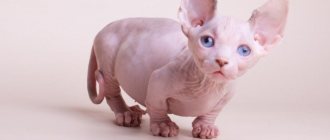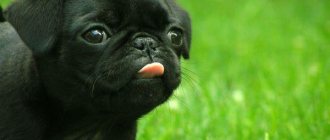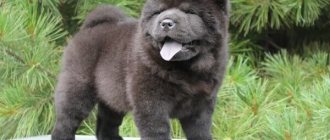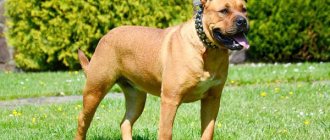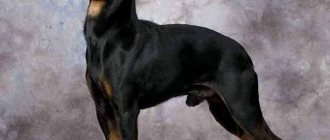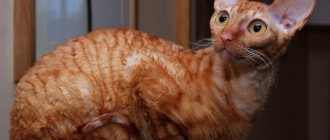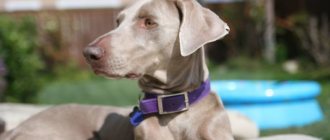History of the origin of Turkish Angoras
global $ads_google;
//data-ad-slot=”2475549904″ $ads_google = empty($ads_google) ? false : true; ?> if ($ads_google == false) {?> $ads_google = true; ?> } ?> The history of the origin of the Turkish Angora is the most natural. There are legends about the breed: one of them says that the Prophet Muhammad had eyes of different colors, and since this phenomenon also often occurs in these beautiful creatures, cats are sacred.
The second legend is associated with the name of the national hero of Turkey Mustafa Kemal Ataturk. Ataturk also had eyes of different colors, and he said that whoever was bitten by the odd-eyed angora would follow in his footsteps. It becomes clear the respect that surrounds a cat in its actual homeland.
Although if you delve into the history of the breed, then most likely the cat arrived in Asia from Africa, probably from Egypt. Europe saw creatures with long white hair and different eyes during the Crusades.
The popularity of cats of this breed made them universal favorites outside of Turkey, in Europe, Russia and then in the USA. They began to be used in breeding the Maine Coon and Persian breeds, but Angora cats became the property of the country.
This breed has European and American varieties and hence a large variety of different colors.
A little history
The Angora is a descendant of the oldest domesticated cats, which have been known since the sixteenth century. The breed received its name in honor of the city of Angora (now Ankara). In the eighteenth century, these cats were incredibly popular among rich people in Europe. Already at that time, such a cat was characterized as very sociable, and its lush fur coat was admired.
After the Russian-Turkish wars, representatives of the breed came to Russia. At the beginning of the twentieth century, such purrs could often be seen in merchant houses.
The most common is the white Turkish Angora. This species is mainly bred in Europe. Please note that the appearance of these cats has changed recently. Some international associations only recognize representatives of the breed whose pedigree includes ancestors brought from Turkey.
Since the mid-twentieth century, clubs in different countries began to recognize Angoras and other colors (blue, red, etc.).
Description of the Turkish Angora
The Turkish Angora cat is not just beautiful - she is chic and impressive at any age. The purebred snow-white beauty is especially associated with oriental grace.
The breed standard is a clearly defined characteristic and description of all external features of Turkish cats.
The small head is wedge-shaped in shape. The neck is medium and graceful.
The muzzle is narrow, with smooth outlines. The jawline is very pronounced. The long straight nose tapers towards the lobe. The color of the slanting almond-shaped large eyes can be green, blue and yellow. An interesting fact of the description is the frequent heterochromia - the heterochromia of Turkish Angoras is very much appreciated .
The ears seem long and set high, their tips are pointed and slightly lowered inside.
The body does not look large. Rather, it is stretched in length, the muscles are well developed. Visually, the cat is slender, with long limbs. The front legs are shorter than the hind legs. The paws are small and round in shape. Tufts of fur are visible between the toes.
global $ads_google; //data-ad-slot=”2475549904″ $ads_google = empty($ads_google) ? false : true; ?> if ($ads_google == false) {?> $ads_google = true; ?> } ?>
The cat boasts a long fluffy tail, somewhat tapering at the end.
Representatives of Angora cats are characterized by silky long hair. There is no undercoat. The fur coat is not prone to getting dirty or tangled, but always flows beautifully. There should be a “collar” around the neck, and “pants” made of wool on the legs. Angorochka is not included in the list of hypoallergenic breeds.
Many people still believe that any white cat with blue eyes is naturally deaf. But in fact, there are no more than 1.5% of such creatures and no therapeutic action is required.
The Angora breed has many colors besides white. Popular colors include black, blue, tabby, red, tortoiseshell, cream, marble. But chocolate, purple and their combinations are not allowed.
Dimensions and weight of Angora cats
The size of the Turkish Angora is average. The height of an adult animal at the withers reaches 25-35 cm. Males always weigh slightly more than females. The weight of cats varies between 3-5 kg. Females weigh 2.5-4 kg.
Kittens reach their height by 12-18 months.
Turkish Angora weight table by month
| Age | Female | Male |
| 1 month | 300-710 gr | 600-950 gr |
| 2 months | 570-1050 g | 900-1400 gr |
| 3 months | 1.2-1.7 kg | 1.4-2.1 kg |
| 4 months | 1.4-2.1 kg | 1.6-2.5 kg |
| 5 months | 1.6-2.4 kg | 1.8-2.9 kg |
| 6 months | 1.7-2.7 kg | 2-3.3 kg |
| 8 months | 1.9-2.9 kg | 2.3-3.7 kg |
| 10 months | 2.1-3.2 kg | 2.5-4.1 kg |
| 1 year | 2.3-3.6 kg | 2.7-4.5 kg |
| 2 years | 2.5-4 kg | 3-5 kg |
Description of the appearance of the breed representatives
The Turkish Angora is a very flexible cat, and compared to other breeds it is larger. She gives the impression of a true lady - elegant, graceful. Her body is proportional, well-built, strong. The neck is powerful and slender. The shoulders and chest are well developed. The back is wide and muscular. The paws are strong and long. The tail is long, covered all over with hair, wide at the base, tapering towards the tip, and has the shape of an ostrich feather.
The head of the representatives of the breed is wide, short, pointed downwards, while the chin is slightly rounded. The nose is medium in size, slightly sloping. The ears are short, pointed at the ends and slightly drooping. The cat's eyes are expressive, blue or light amber in color. Russian Turkish Angoras typically have green eyes. This trait is rare for representatives of the breed from other countries.
Habits and character of the Turkish Angora
The reviews left by owners about Angoras are definitely positive, since the pet’s character is sunny and peaceful.
Domestic Angoras do not particularly like to play or play pranks for a long time; they are very careful and attentive.
global $ads_google; //data-ad-slot=”2475549904″ $ads_google = empty($ads_google) ? false : true; ?> if ($ads_google == false) {?> $ads_google = true; ?> } ?>
The peculiarity of the character of the Angora breed is the recognition of a single leader in the family. It is unlikely that children will be given such a role, but even with them the cat will behave in an exemplary and friendly manner. Strangers will be greeted with caution, and you should not insist on a quick acquaintance.
The habits of the breed are quite phlegmatic: most often you can see the beauty with silky fur reclining on a soft sofa or pillow. You can be sure that the pose will be the most regal and majestic.
For owners who live alone, such a cat will be a true gift - the animal also appreciates silence. The owner will also be glad that the cat’s calm nature does not allow the cat to tear wallpaper and furniture, ignore the litter box, and behave unsightly at the feeding area.
How to litter train a Turkish Angora
An elegant beauty does not mind spending a little time exploring the territory of a house or apartment; she is capable of catching a bird that has flown in or a mouse that has inadvertently wandered in.
The description of the breed's voice is very interesting: seals do not meow, but make guttural sounds with their mouths closed.
Choosing toys for a little purring friend
In general, representatives of the breed are calm, but at the same time they are not devoid of playfulness, in particular, young individuals and kittens. The Turkish Angora rarely lies down, but if you notice this, you can try to attract its attention with bright toys that make sounds.
Feather items should not be left unattended. The cat may eat feathers, after which it will be necessary to go to the veterinary clinic.
If your cat ignores traditional products, then you can use toys soaked in catnip (they are also sold in regular pet stores).
Care and feeding of the Angora cat
The fur of a Turkish Angora cat can be compared with such breeds as the Somali, Neva Masquerade, and Ragdoll. But, despite this length of the pile, combing the fur coat will not be difficult. It is enough to do this with a furminator 1-2 times a week. But during the molting period, you will have to take care of the coat every day.
The care includes water treatments. Cats also need to be bathed, but not often. You can do this before an exhibition or when there is obvious contamination using a special gentle shampoo.
Ears and eyes need to be cleaned: they are washed with a damp cotton pad as needed. Nails are trimmed regularly. Claws are trimmed once a month.
Keeping a cat requires a responsible approach to feeding issues. Meals, so frequent at a young age, become two meals a day.
What to feed a two month old kitten
Angoras are fed a standard cat menu. The usual diet includes natural or ready-made food. The cat eats proteins, vegetables, lactic acid products and milk, meat and offal.
You can pay attention to the line of ready-made premium wet and dry food, where the composition is always balanced for the cat’s body.
How to choose a kitten
If you want to buy a healthy kitten that truly belongs to the Angora breed, contact only specialized nurseries. Be sure to look at the parents' pedigree. Buyers line up for snow-white kittens several months before the birth of the next litter. If you want to get a furry friend sooner, pay attention to Turkish Angoras of other colors. The kitten must stand confidently on its feet and be accustomed to food. Healthy animals are playful, although cautious, and do not have kinks on the tail or areas of matted fur.
Diseases of the Angora cat breed
The cat is included in the list of long-lived breeds, and, nevertheless, some Turkish Angora cats are sometimes diagnosed with a cardiovascular disease called hypertrophic cardiomyopathy.
There is also a unique disease of Turkish Angoras: ataxia. When the disease occurs, the coordination of movements in a kitten several weeks old is impaired. Breeders remove such sick pets from breeding and test the animals for the presence of unwanted genes.
The third deviation of Turkish Angoras is possible congenital deafness in blue-eyed offspring from two white animals.
In general, the health of Angora representatives is good, especially if you do not miss vaccination dates, get vaccinations under veterinary supervision and treat your pet with vitamins. Animals normally do not suffer from elevated body temperature.
The time frame for spaying or neutering a pet is approximately the same: 7-9 months, before the first heat.
Mating takes place quietly within 2-3 days in the male’s territory, and pregnancy proceeds smoothly.
The first birth can take quite a long time, but Angora kittens are usually healthy and strong.
How long do Turkish Angoras live?
In order for your pet kitty to enjoy many years of life, you need to provide competent care for it, not ignore the advice of a veterinarian, or contact the breeder for recommendations by phone or through the website.
At home, the life expectancy of Turkish Angoras averages 15-18 years. If the cat is healthy and well-groomed, then the age bar rises to 20 years.
Feeding the breed
If we talk about nutrition, these cats are not picky eaters. But still, their feeding has its own characteristics. Which ones exactly? Now we'll tell you.
A special diet is not required for such cats, but you need to make sure that the purr is well fed and that all the necessary microelements and vitamins enter its body. This is especially true for kittens. After all, many health problems arise precisely because of improper feeding and lack of necessary substances. Let us note that much more money is spent on treating diseases acquired due to poor nutrition than on balanced feeding. Therefore, every owner must take care of their pet’s diet.
The smallest kittens should be offered special food, supplementing the diet with milk (low-fat, of course). If you don’t plan to feed your pet finished products in the future, then you should talk about natural nutrition with your veterinarian; he will tell you what and when to add to the little fluffy’s diet.
You can additionally give your pet vitamins for the coat. As kittens grow older, they need calcium to keep their bones and teeth strong.
Buy a Turkish Angora kitten
Since the Turkish Angora is quite common in Russia, there are usually no difficulties in purchasing it: there are many nurseries in different countries and buying a kitten is not a problem.
global $ads_google; //data-ad-slot=”2475549904″ $ads_google = empty($ads_google) ? false : true; ?> if ($ads_google == false) {?> $ads_google = true; ?> } ?>
A person who cannot distinguish a pedigree cat from a mestizo should ideally seek help from a specialist breeder, and not on sites like Avito or Yula: it is doubtful that an official cattery will offer its services there.
If a cat is white, this is not proof that it is a true Angora; it is not always white: it may be an Angora chinchilla, a Turkish shorthair, or even a Van cat.
Cats are not rare, so the cost of an Angora cat kitten with a pedigree and a pure genetic line is about 25,000 rubles
.
Pet and breed class kittens are cheaper, their price ranges from 5,000 to 20,000
rubles.
What to call a Turkish Angora
Naming a furry fairy boy or girl Angora is not so easy. This is because the kisul is so pretty - giving any nickname to such an animal is simply out of hand.
Turkish Angora kittens are distinguished by their beauty in any photo, and in real life these bundles of happiness even more so deserve special names. You can ask the breeder for advice, contact other owners, or choose a beautiful nickname from a ready-made list. But it’s better to name the cat so that it reacts sensitively to the nickname and it suits it perfectly.
| Girl | Boy | ||
| Taiga Palma Java Ruby Snezha Tesla Bentley Gris Frida Fiesta Whitey Iva Tella Utah Besta | Kuzya Yamka Fronda Caramel Bella Syusya Dzhulya Gerta Maruska Gucci Yara Aina Snezhinka Lota Chucha | Foxy Cornet Prime Filya Aramis Chips Carat Saffron Luxie Leo Donut Zhorzhik Eunice Zieger Duchess | Syava Behemoth Mozambique Assar Obormot Fonya Mirlan Evrik Elbar Makhno Oboe Whitefish Darley Nicolas Dyma |
What should you buy before getting this cat?
If you decide to place a Turkish Angora in your home, you need to prepare in advance. First of all, you need to buy two bowls (for water and food). If we talk about what kind of dishes to choose for this cat, then rely on your taste. The cat will not play even with a plastic plate; it is not interested in it. What she can get carried away with is food. If you buy a plastic plate, make sure that there are no cracks, burrs, etc. on it.
A scratching post is another necessary thing that will help protect your furniture and wallpaper. You need to get used to it, as well as to the tray, from the first days the kitten appears in the house. What kind of toilet does a cat need? There are many options available in pet stores now. Even the most ordinary tray will do, however, sand will fly out of it onto the floor. To avoid this, you can use a closed toilet or one with a net. Of course, the second one is cheaper, but the first one has the advantage of excellent odor neutralization.
No matter what kind of toilet you use, it should always be kept clean. Which filler should I choose? In this matter, you need to focus on the cat’s preferences and financial capabilities. Many people praise clay filler, since it most closely resembles regular sand, just choose the one with larger granules. You can buy another one, for example, wooden or silicone. You need to change the filler in the tray as you use it.
Conclusions about the breed
Known beyond its hometown of Ankara Zoo, the Turkish Angora is renowned throughout the world for its virtues:
- calm and affectionate character, ability to get along with small households and lack of desire to spoil interior items;
- cats have good health and a high level of immunity;
- The amazing grace, elegance and beauty of the fur do not require much care and heavy maintenance.
On the Internet, lovers share various videos about the antics of their Angoras, and it becomes clear what causes such love on the part of people.
global $ads_google; //data-ad-slot=”2475549904″ $ads_google = empty($ads_google) ? false : true; ?> if ($ads_google == false) {?> $ads_google = true; ?> } ?>
Caring for ears, claws, eyes and teeth. Tips for Angora owners
It is also necessary to monitor the condition of your pet's teeth. They should be cleaned regularly using a special toothpaste and brush. Of course, carrying out such a procedure every day will be a little expensive, but it needs to be done twice a week.
The eyes should be wiped with cotton pads, removing secretions daily.
Ears must be cleaned using cotton swabs and a special care product. You need to remove plaque from the visible surface; you don’t need to go too deep so as not to damage anything.
Claws should be trimmed as necessary. For these purposes, it is worth purchasing a nail clipper. It should be light and comfortable. It is desirable that the handles of this tool be rubberized.
Diet selection
Any cat can receive two types of food - ready-made and natural. First, you should choose food from a professional line that has a high-quality, balanced composition. This food is made from meat, vegetables, grains, and has added minerals, vitamins and other substances necessary for the body. Natural nutrition should not consist of food from the human table. Such food can harm the health of the animal. An Angora cat's diet should not contain:
- fatty meat;
- sausages, sausages;
- smoked products;
- spices;
- sweet.
It is not recommended to give white animals liver or heart, or sea fish. In this case, there is a risk that the wool will acquire a yellow tint.
Food for this breed should consist of:
- boiled or frozen meat;
- fermented milk products – kefir, cottage cheese;
- raw vegetables, fresh herbs;
- cereal porridge.
It is advisable to give your cat sprouted oats, as their wild counterparts eat fresh grass. At home, there is no such opportunity; this is why such crops are sprouted. The animal must also have constant access to water.
Shelf for cats
Choosing a kitten and cost
It is best to purchase from nurseries, which are located in all major cities of Russia, or from a breeder with good recommendations. You should pick up a cat no earlier than 1.5 months (the optimal age for moving to a new home is 2.5-3 months). From 1.5 months it is already possible to determine how well the animal hears.
The kitten should be active, playful, with clear eyes, ears and a soft tummy. An elastic, tense abdomen indicates a possible helminthic infestation. Prices for kittens depend on the class and color, but in general they are low: from 5 to 15 thousand rubles.
Photo gallery of Turkish Angoras:
1111
Training and education
Many owners of Turkish Angoras boast that their pets are able to carry out certain commands. Perhaps this is so, but still you should not expect too much from a proud and independent animal and treat it like a circus bear. If a cat follows any commands, it perceives it as a game with its beloved owner. As soon as the animal feels that its freedom and dignity are under threat, it will immediately show you “who’s boss.”
The very concept of “training” in relation to a cat walking by itself sounds blasphemous. However, this does not mean at all that there should be no prohibitions for a pet in the house. Not at all, on the contrary, good manners and observance of basic rules of behavior and hygiene are an essential part of “getting along” with a four-legged household member. The minimum that is mandatory for a domestic cat to comply with is the fulfillment of natural needs only in a specially designated place and the point of claws only using a scratching post. The rest, for example, the ban on jumping on the table, is at your discretion.
Coat colors and features
The quality of the coat is of particular importance; Angora cats are characterized by a coat of medium length, completely devoid of undercoat. The hairs are longer on the neck, tail and panties.
The tone of the Turkish Angora fur coat can be monochrome, as well as two or three colors:
- The tortoiseshell combines a black coat with red and cream spots.
- There are 2 options for the smoky color of Angora cats. The Blue Smoke has a white base coat and blue-gray guard hair, while the nose and paw pads remain gray. In another case, the black tint of the nose, paws and cover is combined with a white base of the hairs.
- Wide variety of striped colors. Tabby shades can be blue, cream, marbled, brindle, patchwork, silver, red, brown.
- Solid colors include blue, cream, red, classic white and black angora.
- Bi-color combines a snow-white shade with any of the primary colors or bluish-cream.
- The Calico has a light base with tan and black markings.
- Bleached chintz suggests a white cover with spots of gray and cream.
The coat of a Turkish cat should not be acromelanic, that is, change tone under the influence of temperature.
The following colors or their combination with white are unacceptable for the Angora breed:
- chocolate;
- cinnamon;
- faun;
- lilac;
- Himalayan.
Diseases and health problems
In general, Angora cats are in excellent health and do not get sick very often, thanks to their innate strong immunity.
A couple of decades ago, cats with deafness were often encountered due to acquired genetic mutations. Moreover, the appearance of deafness was typical only for blue-eyed individuals with white fur. Thanks to selective selection and the ban on mating two white Angora cats, the risk of this pathology has been significantly reduced. In Western European countries, currently all purebred cats with white fur are necessarily checked for deafness using a special test.
In addition to deafness, the Turkish Angora suffers from two more serious diseases: ataxia and hypertrophic cardiomyopathy. Hypertrophic cardiomyopathy is caused by hypertrophy of the heart muscle.
Which is manifested by the following symptoms:
- Cough;
- Dyspnea;
- Fatigue during exercise.
If the disease is diagnosed in time, it can be quickly and successfully treated. A disease such as ataxia occurs only in Angora cats. Its symptoms manifest itself in a sharp loss of coordination of movements, after which the animal completely stops moving and dies. Unfortunately, today this disease has no cure yet.
In addition to a few diseases, Turkish Angoras may have some defects in appearance that do not allow them to participate in exhibitions. These include being too large in size, having a head that is too round, short limbs, a somewhat squat build, and a knobby or insufficiently long tail.
Life expectancy and most common diseases
On average, cats of this breed live 10-15 years. With serious illnesses, life expectancy is reduced. But with proper care and good nutrition, healthy cats can become true long-livers, living with their owners for about 20 years.
The most common disease of the Turkish Angora is deafness , which is inherited genetically. An unpleasant disease can be detected even in a small kitten. Cats that are white and have blue eyes are most prone to this disease.
You can name another unpleasant disease, which is much less common. It is associated with improper coordination of movement.
Video
* We invite you to watch a video about the Turkish Angora . In fact, in front of you is a playlist in which you can select and watch any of 20 videos about a given cat breed by simply clicking on the button in the upper right corner of the window. In addition, the material contains quite a lot of photos. By looking at them you can find out what a Turkish Angora looks like.
Rate the material!
[Total votes: 2 Average: 3]
With long, silky fur and a fluffy tail, slender paws and multi-colored eyes, the Turkish Angora is so beautiful that it seems as if it has just stepped out of the pages of a fairy tale book. Her beautiful appearance is perfectly matched by her royal stature and grace, as well as her dog's devotion to her master. Thanks to a considerable number of positive qualities, the Turkish Angora has earned enormous popularity among cat lovers.
